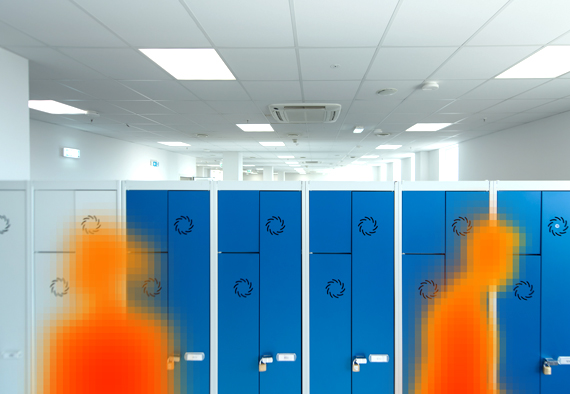How intelligent lighting solutions in buildings can contribute to the fight against the coronavirus pandemic.
Six o’clock in the morning. Another bus stops in front of the OSRAM plant in Plovdiv, Bulgaria, and more employees on the early shift get out. A line of workers is already forming at the entrance. Since the start of the coronavirus pandemic a few months ago, they need a little longer in the morning to enter the plant. A display next to the entrance tells them if it is OK to enter. That is just one of the many measures that have been put in place in the fight against COVID-19. And it is directly related to what comes out of the plant, namely light-based products for smart building systems.
The heat is on
“Everyone radiates body heat. Infrared array sensors detect a pattern of heat signatures and calculate the amount of people within an area. We are making use of this in Plovdiv to alert if there are too many people in a confined space. This way, we can minimize the risk of infection,” explains Markus Jung, Software Engineering Manager at OSRAM Connected Building Applications. “If the sensor detects too many people, it relays this information to a display next to the entrance. Employees see either a green light telling them it’s safe to enter or a red light telling them to wait.”
The traffic light system in Plovdiv ensures that everyone can maintain a safe distance from colleagues in confined spaces, such as changing rooms or the entrance area. One infrared array sensor is sufficient for a room size of up to 20 square meters. It sends the number of registered heat sources to the cloud, where the data is processed and delivered to the display as information.

New tasks for existing technology
The solution is based on the “SiteWorx” cloud platform which OSRAM subsidiary Digital Lumens has been successfully using for years to improve operational processes. It accepts data from sensors that are either mounted separately on ceilings or are integrated in the ceiling lighting. “The ceiling lighting provides the ideal network infrastructure for integrating the sensors because it is installed uniformly wherever people gather,” explains Jung.
“The idea of using this existing technology as a safety measure during the coronavirus was an obvious one,” says Jan-Philipp Kittler, Business Development Expert at Digital Lumens. “The anonymized information, which includes the volume of people and movement patterns, is instantly displayed for management in the form of graphics in the web application.” Thanks to real-time transmission, employees can also be alerted immediately if there are too many people already in an area – as with the display in Plovdiv.
Bluetooth to the rescue
Infrared sensors are not as effective for detecting the number of people in production and assembly areas because of the heat emitted by the machinery. So Digital Lumens is relying on a similar principle but with a different proven technology, namely Bluetooth. “In production areas we can determine the number of employees by using beacons,” says Jung. “The coin-sized Bluetooth transmitters can be integrated in employees’ ID cards, for example.”
The beacons send signals to Bluetooth receivers on the ceiling. These can be attached to or integrated into existing luminaires with an appropriate plug-in module. With a range of up to 30 meters, they can even cover large rooms. A gateway gathers the information and passes it to SiteWorx where the movement patterns of employees are anonymized and evaluated.
“This solution supports security measures in buildings: for example, it allows for geofencing which protects sensitive production areas,” adds Jung. “SiteWorx sends an alert if an unauthorized person enters such an area. By recording the occupancy levels in rooms, the system now also serves as part of the measures to prevent coronavirus infections.”
No unnecessary journeys
OSRAM is already using Bluetooth technology at its plants in Plovdiv and Herbrechtingen, Germany to track transport trucks. The mobile metal boxes for transporting the products are equipped with beacons that send location signals to Bluetooth receivers in the ceiling. The information is available to every employee via a web application. “It shows workers the exact locations of the transport boxes, saving them unnecessary journeys,” says Kittler. “In addition to saving time, the elimination of wasted journeys is a positive side effect, particularly during this pandemic.”
Whether the issue is crowded offices and factories or unnecessary journeys, the software suite Siteworx enables plant managers to make data-driven decisions and take targeted measures to protect employees. Kittler sums it up as follows: “Our intelligent building solutions for presence detection help to make the day-to-day work of employees more efficient. And in times of the coronavirus, they give them extra security.”